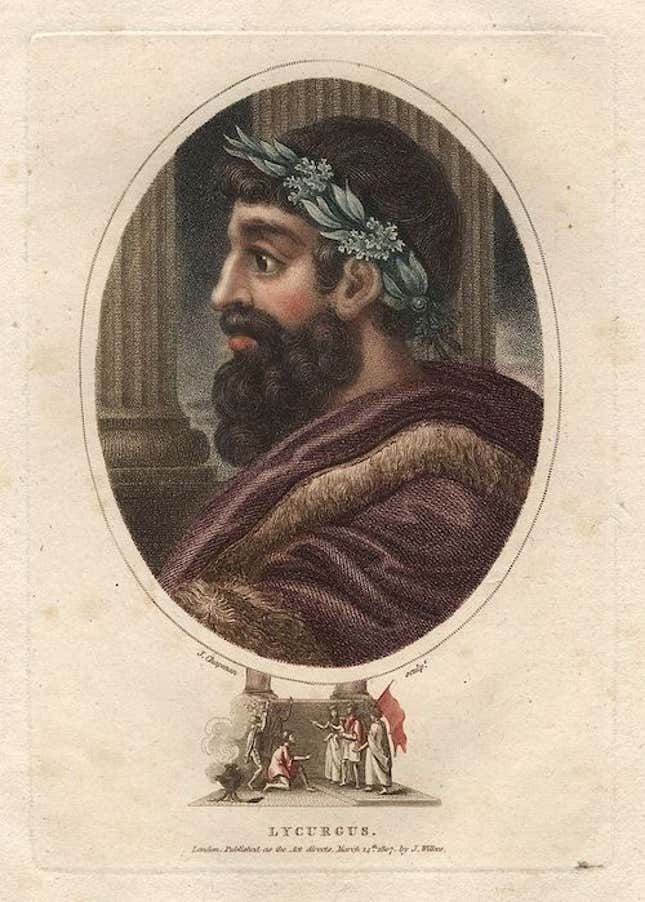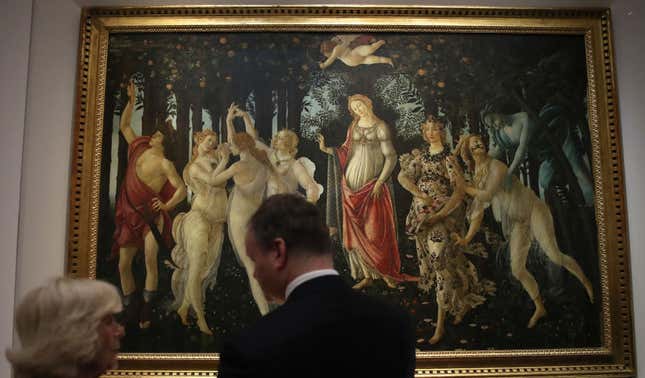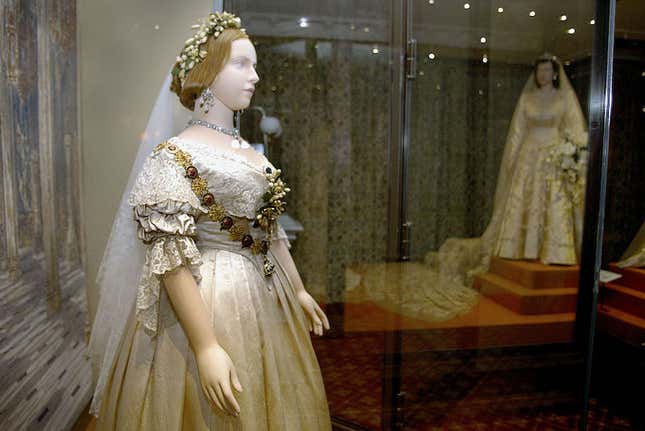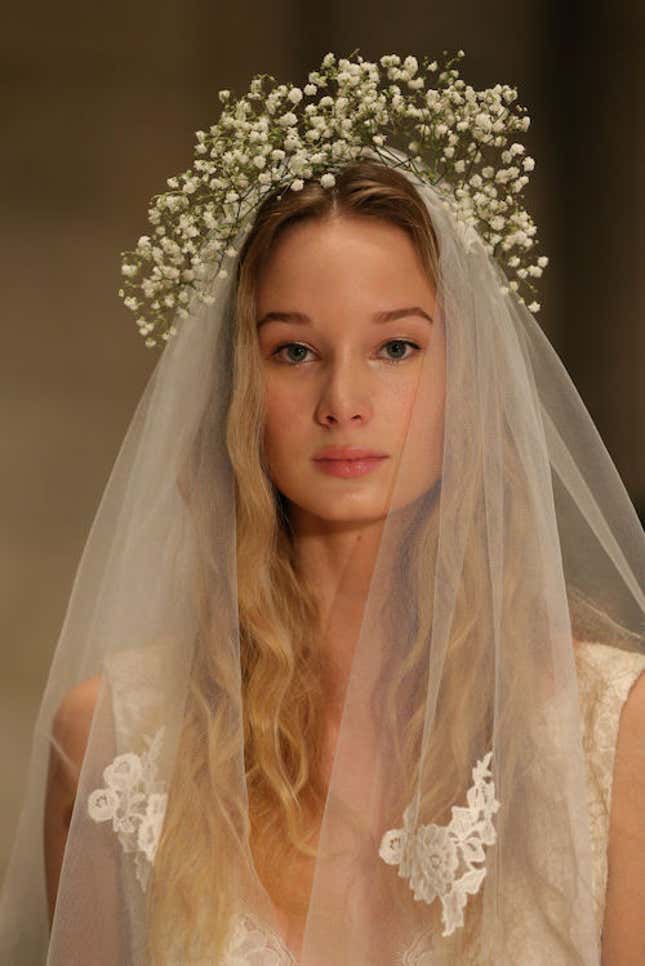
Image: Elena Scotti/GO Media
The story begins as too many stories starring women do: Daphne didn’t want to have sex. She was a nymph, a minor goddess of sorts, daughter of a river god, and beautiful to boot. According to Ovid, her father wanted grandchildren, but Daphne wanted to stay free, her body untouched by lust, forever her own. “Dearest father, let me be a virgin forever,” she begged. He relented, but omniscient narrator Ovid cautioned, “Your beauty itself Daphne, prevents your wish, and your loveliness opposes your prayer.”
She was, according to this ancient logic, too attractive to have agency. From here, the story blends into a chase scene. The sun-god, Phoebus Apollo, sees Daphne and wants her. “Like a hound of Gaul starting a hare in an empty field,” he ran after her, as intent on his rape as she was on her freedom. At the last minute, her father lends her aid and turns the nymph into a laurel tree. (Though he doesn’t truly fulfill her wishes. She asked for him to “destroy this beauty” and he couldn’t, or wouldn’t, give her that.) Ovid is on Apollo’s side. Apollo “loved her” still, and continued to claim her. “Since you cannot be my bride, you must be my tree!” He took her branches and made them into crowns for his generals. He wreathed his hair with her leaves. He took apart her new, deciduous body, and used it as he wanted. Of course he did; he was a god.
As far back as ancient Greece, heads have been decked in leaves and wreaths, blossoms and buds. The practice was never reserved just for the gods, but it was practiced primarily by two groups: the triumphant and the faithful. And when I say faithful, I mean those who were faithful to systems of power. Those who worshipped properly, who were willing to give up their bodies to prop up military might or tyrannical rule. It might seem as though this has changed. But flower crowns, seemingly innocuous, seemingly innocent, still tell strange stories about power and beauty, who has it, who doesn’t.

For the Greeks, crowns of leaves and flowers were used as trophies, honorary rewards given to “victors in athletic, military, poetic, and musical contests,” writes Emilie Carruthers. Since the contestants were male, the winners were male. The Romans followed suit, but they added another use for green headpieces. They were an early hangover cure for upper-class men. During their Bacchus-inspired quasi-intellectual wine-soaked orgies, they tied tight pieces of wool around their heads to keep them together, I guess. They decorated their stylish wool headbands with roses, violets, myrtle, and parsley. It probably didn’t work that well, but it looked cool in party pottery.
As Christianity rolled into town, flower crowns fell by the wayside—at least, for a while. It wasn’t cool to wear pagan symbols during the Middle Ages, and perishable headpieces had a certain Dionysian vibe that didn’t go well with the rule of the day. During the plague, people filled their pockets with flowers in hopes of keeping away death, as well as masking the smell of rotting corpses piled everywhere, but they didn’t wear them. They were too busy digging graves, I imagine. Flower crowns appeared less frequently in art, though occasionally religious figures (both men and women) were shown wearing them. It is, after all, a very solid look.
It’s hard to pinpoint the moment the flower crown became a symbol of feminity rather than masculine conquest, but from the Renaissance onward examples abound of glorious goddesses, flowing tresses laden with petals. Sometimes, these images of womanly perfection were allegories for spring, other times they were depictions of classical goddess or heroines. It was somewhat safe to bring these pagan figures back into the cultural consciousness through art—religious power had been consolidated in the Church, and they felt secure in their rule. (They were secure in their rule, at least against the tiny number of living pagans who had very little power in this feudal world.) Plus, it was a way to reinforce certain cultural values about womanhood. Flowers were tied to the land, to spring, and to the season of fertility. They were still coded ways to show an ideal version of a person, but instead of resting on the brow of a military leader or a virile would-be rapist god, they now topped the heads of society’s most significant breeders. A good woman was one who could bare healthy children and look pretty.
She was fecund and round and bursting with life, like in Botticelli’s Primavera (1477-82) or Bartolomeo Guidobono’s Allegory of Spring (1705-9) or Luca Giordano’s Flora (c. 1697). As a symbol for both purity and fertility, the Virgin Mary is often shown wearing white lilies or tangles of roses. Pagan symbols have often been co-opted by Christianity to help consolidate their power amongst the lower classes, so using floral crowns in ostensibly Christian art makes a certain kind of sense. (While witches celebrate Beltane by dancing around the maypole, Catholics can celebrate the same date by “crowning” statues of Mary with flowers. Both these traditions have endured for hundreds of years, and may keep going for a hundred more.)

As a currently pregnant woman, these paintings don’t, surprisingly, make me want to wear a flower crown and stage a Beyonce-inspired photo shoot. (Plus, sometimes it’s worth recognizing when the pinnacle of an art form has been reached already—Taylor, take note.) What I used to think of as fun and frivolous now looks a bit stifling. Plus, linking women to the land on which they live sounds lovely and hippy and bohemian, but it’s not always. Adolf Hitler, for example, used imagery of blonde, thick-armed German women with their feet planted in soil, as propaganda for his genocide. He admired Greek and Roman culture, and he drew on their aesthetics (as well as their mythology) to help promote his vision of a “pure” German nation. According to the New York Times, when Hitler attended the 1936 summer Olympics in Berlin, “a little girl in blue, her fair hair bound by a chaplet of flowers” came forward to present the ruler with a bouquet of roses after making a “pretty German curtsey.” I couldn’t find images of this event, but I did find another Hitler youth in a flower crown—this one is now an old lady who lives in Missouri and says things like “Hitler was trying to do the best thing for the German people.”
On a child, a flower crown reinforces their purity, but even children with flowers can be twisted in the name of power. Little girls are surprisingly good propaganda tools. They’re sweet and innocent and even if she does turn into an 86-year-old Nazi proudly chatting about her glory days to the Daily Mail, who could hate a little kid? Perhaps it’s because my name literally means pure, I’ve always chafed at the word. Both purity and fertility seem like fine things to value, at first glance. But history shows us that these supposedly “nice” attributes can be used as ropes to tie up women, hold them down, keep them immobile as a laurel tree.
In the 18th, 19th, and early 20th centuries, flower crowns were symbols of beauty, spring, fertility, purity, and joy. That’s a real mixed bag, but all these concepts come together in one place: the wedding. In 1840, Queen Victoria wore a crown of orange blossoms for her wedding to Prince Albert, an idea that may have been stolen from Chinese tradition (in China, orange flowers were symbols of purity, chastity, and innocence). The Queen was an epic trendsetter, and non-royal brides were quick to follow her lead.

What was fashionable in life was also fashionable in art. In the 1850s, the Pre-Raphaelites began putting petals in the hair of every mythological or literary figure they depicted, from Ophelia to Guinevere to Joan of Arc. They were a way to highlight the ethereal, magical beauty of beloved characters while nodding to the styles of the day (as well as the Pre-Raphaelites’ idiosyncratic sense of beauty). Dante Gabriel Rossetti’s The Bride (1865-6) depicts a virgin maiden surrounded by virginal companions holding bouquets of roses and lilies. Here, the concepts of fecundity and purity come together sumptuously and seamlessly. According to the Tate London, where the painting is currently held, the subject of this painting is both “the power of woman’s beauty” as well as the marriage of Dante’s Beatrice, a subject Rossetti fetishized. Like many allegorical paintings, it’s about one celebrated woman, but it’s also about brides in general, women in general, weddings in general. In wedding ceremonies, we’re simultaneously celebrating unbroken hymens and the possibility of childbirth. Long hailed as the most important day of a woman’s life, the wedding is where she can be at once pure and sexual, unblemished and fertile. It’s no wonder that the flower crown continues to be a favored accessory for BHLDN-inspired brides around the globe.

But a wedding is just one day, and like many wedding fashions, the flower crown spread outwards into other events, other special occasions. They were worn at midsummer festivals and artificial flower headpieces (often made with poisonous arsenic dye) were worn by Victorian party-goers. Since Marie Antoinette cosplayed poverty, floral crowns were a way for the upper classes to dabble in land-based worship. They didn’t have to work the land, but they could still celebrate it. They didn’t work it, but they appreciated it. It was a way for people to bring some greenery into their lives, to inject a very small, socially sanctioned bit of wildness into their brownstone ballrooms. Of course, country girls could make flower crowns and wear daisy chains and dandelions on their heads, but no one was taking their pictures.
In the late 20th and early 21st century, flower crowns continued to exist as symbols, though they lost much of their potency. A few artists have used flower crowns in subversive ways, particularly women of color (Frida Kahlo and Billie Holiday both made flower crowns part of their trademark looks). In general, visual symbols have been diluted with the advent of the internet. It’s too easy to muddle the visual waters, to represent something in multiple ways, to claim, disingenuously, that your white power symbol was just a joke or your green frog meme is just a cartoon. We understand what flower crowns mean when we see them at music festivals—they’re a symbol of debauchery. We don’t have Bacchanalia anymore, but we do have places that exist solely to see and be seen. In these environments, it’s important to look your best, but also to appear a little bit wild. The flower crown fits in perfectly—it’s shorthand for a certain kind of fun, had by a certain kind of person. It’s still a symbol for the bohemian child of privilege. The people who grow and pick flowers for a living, the people who grow and pick food, they don’t wear crowns of greenery. They don’t have the time or income.
Except in the digital realm, where anything is possible and just a filter away. This is, perhaps, my favorite iteration of the headpiece. With one finger to the touchscreen, you can transform yourself into a flattened, surreal version of a person, complete with big eyes and eyelashes that wink, maybe even doe ears. There’s a certain freedom in this easy digital shapeshifting. Anyone can access this mode of being and transform themselves into an allegory for spring, so long as you have internet access and a camera. Gender doesn’t matter so much in the digital world, which is actually something of a minor miracle. There’s freedom in the flat image, freedom in the manipulated photograph.

But there’s also a sense of strangeness. Nature words are disappearing left and right, and so are entire species. There will come a time when there are only digital flowers, and all we can point to is our digital power, our online money, our online relationships. Like flowers, which can be symbols of bodily freedom and oppression at once, this new world is expansive and claustrophobic.
Katy Kelleher is a freelance writer and editor who lives in the swampy woods of Maine. She writes about weird art, bad looks, good taste, and forgotten colors.